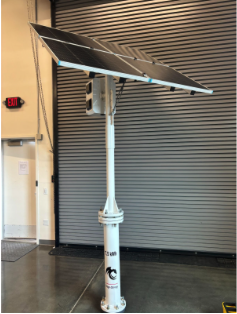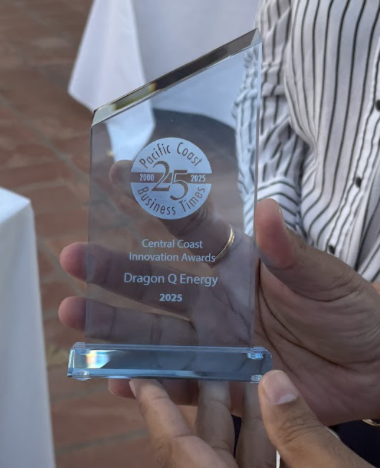From Concept to Community
- liam21877
- May 1
- 5 min read
Updated: May 2
CNSI/Bren School - Proof of Concept Grant

Over the past year, Dragon Q Energy has been proud to participate in the CNSI/Bren School Proof of Concept (PoC) Grant program — a joint initiative from the California NanoSystems Institute and the Bren School of Environmental Science & Management at UC Santa Barbara. The grant is designed to help early-stage technologies bridge the gap between concept and deployment by providing targeted funding for prototyping, testing, and real-world validation.
In our case, the grant made it possible to move our battery innovation from sketches and simulations into fully integrated field-ready systems. It also allowed us to bring on a talented group of undergraduate and graduate interns from UCSB, who played a key role in engineering, testing, and demonstrating our technology across a wide range of use cases — from disaster relief to telecommunications infrastructure.
This report highlights the outcomes we’ve achieved through that support.
Innovation & Progress
Battery Management System Development
We developed and tested a basic battery management workflow to support system safety and monitoring. Initial integration included connectivity features for user access and remote oversight. Based on customer feedback and internal testing, the team identified key requirements for future development and began outlining a more customized control interface for production units.
Pairing the BMS to the Build Pack
Our team successfully integrated the battery management approach into the system’s structural and electrical architecture. The focus was on ensuring safe operation within the compact design constraints of the PowerPole. This work contributed to refining the internal layout and informed future manufacturing considerations.
Pack Assembly and Testing
We developed and iterated on an assembly method designed to maximize contact reliability and minimize part complexity. Prototypes were built and tested to evaluate performance under various use cases. The learnings guided improvements in pack structure and ease of assembly.
Cell and Module Testing and Quality Control
Standard testing procedures were implemented to verify key performance indicators of cells and modules. The process helped ensure consistency across builds and surfaced insights that are now part of our internal QA documentation. These quality control steps are essential to future scaling and field reliability.
Proprietary Developments
The grant period led to early-stage innovation that has informed our ongoing IP development. Certain internal components and system strategies have been flagged for further protection and potential patent activity.
Electronics Cabinet and Power Management System Development
The electronics team led schematic development to meet future UL508 testing standards, selected and integrated components for customer demonstrations, and assembled fully functional electronic cabinets for customer demonstrations. By using KiCAD schematics and sourcing Victron modules, fuses, and terminal blocks, the team executed panel fabrication: drilling aluminium sheet metal, threading screws, and finding suitable materials for sheet metal bend, shear, and break. The team identified correct wire gauges that include both 12V and 48V circuits, delivering prototype cabinets that would pass all functionality tests.
Key challenges that the team had to solve included sourcing UL listed components and maintaining an efficient parts database to streamline component selection. The team also ensured precise hardware alignment within the cabinet’s dimensional constraints and optimized wire routing to prevent overlap or contact with the sheet-metal enclosure.
Schematic Development for UL508 Testing
Competent Selection and Integration for Customer Demonstrations
Electronic Cabinet Assemblies for Demonstrations

Customer Demonstrations
Malibu Boys and Girls Club - DQE Response to Palisades Wild Fires (Link)

In January 2025, the DQE team deployed a PowerPole unit at the Malibu Boys and Girls Club in response to the Palisades wildfire disaster. DQE advisors suggested the project, and was instantaneously supported by team members in coordination and installing effort. The demonstration provided backup power for device and computer charging and two Wifi access points to support ongoing relief services for the B&G club during recovery. The MVP PowerPole was up 100% providing electricity and Wifi for 18 days completely uninterrupted; and there was a period of 5 days where DQE provided the only power and wifi to an area of downtown Malibu. The installation highlighted the PowerPole’s role in community resilience and was featured in this blog.
Cal Poly Connectivity Demonstration
In March 2025, the DQE team deployed a PowerPole unit at Cal Poly’s 5G Innovation Hub as part of the BEACON (Battery-Enabled Autonomous Cellular Offgrid Node) project. The demonstration, supported by the entire DQE team, successfully showcased the PowerPole’s potential for powering telecommunications infrastructure in remote areas. The event attracted interest from Cal Poly faculty and private network experts, laying the groundwork for future research and field pilots.
CalPoly 5G innovation hub - BEACON (Battery Enabled Autonomous Cellular Offgrid Node) demonstration

Direct Relief - Street Light and Connectivity Demonstration
The DQE team conducted a successful demonstration at Direct Relief, in collaboration with Spitzer Lighting and 16500 Manufacturing Representatives. Three battery packs were deployed, two powering lighting systems and one supporting telecommunications, each fully operational and remotely accessible. The lighting systems incorporated pole components supplied by Spitzer Lighting. The installation was a success with support from team members including Alexander Mintsa (Business Development Intern), Ameya Gandhi ( Engineer Intern), and Dipesh (Finance) showcased the system’s reliability and strengthened partnerships for future deployments. Santa Barbara Airport Engineers were invited to the demonstration and the sales team from Spitzer Lighting are specifying the DQE technology in a bid to power crosswalk lighting near the airport terminal area.
Direct Relief w/ Spitzer Lighting and 16500 Manufacturing Representative - Street Lighting and Telecommunication Demonstration
Customer Discovery and Product/Market Fit
Industrial Partners:
Fortune 500 Oil & Gas Company - Remote power stations, connectivity and private networks.
Vertex Imaging Solutions - Optical Sensor power and connectivity platforms
Telecommunication Partners:
Kajeet - Network Integrator
Ramen - Network Integrators
Baicells - Telecommunications Radio Manufacture
Pente Networks - Mini Edge computing devices
Commercial Lighting Partners:
Spitzer Lighting and Energy
16500 Manufacturer Representative
Direct follow on work projects
10 Unit Santa Barbara County Community Resilience pilot project. Collaboration with James S Bower Foundation and Unite to Light. Secured funds for Q3 2025 installation and 1 yr monitoring and management. (Link to press release)
25 Unit telecommunication and electrification validation project - Swanton Ranch, Santa Cruz CA. Potential earmarked funds through Cal Poly and Congressman Panetta - District 19 Office.
Q2 2026
LOI From Gabon Office of Investment - Try, decide, then potential to buy
Awards
Pacific Coast Business Times - Central Coast Innovation - Breaking New Ground
On March 20th, 2025, Dragon Q Energy was honored with the Breaking New Ground award at the Pacific Coast Business Times “Central Coast Innovation Awards.” The DQE team: Daniel Casey (CEO), Dipesh (Finance), Rosalind (Engineering intern), and Alexander Mintsa (Business Development Intern) attended the event, set up a booth, and shared the PowerPole project with investors and regional stakeholders. The team received the award on stage and delivered a speech highlighting DQE’s mission and growing impact. Link to News

















